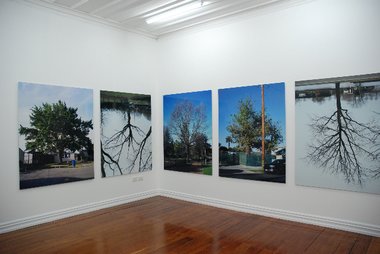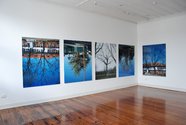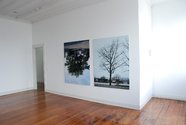John Hurrell – 15 November, 2011
Maybe Shelton is saying that evil, if it is always something palpable and identifiable, is an entity we should be wary of attempting to identify in places beyond ourselves - that it dwells happily within all neighbourhoods; perhaps our own back yards.
In both traditional art and contemporary, oak trees have appealed to artists. Constable painted carts of hay leaning up against their trunks, Callot showed mercenaries being hung from their branches, Beuys planted the first of seven thousand saplings in 1982 and Michael Craig Martin turned a glass of water into one in a gallery.
Ann Shelton’s show upstairs in Starkwhite focuses on the fact that during the 1936 Olympic Games in Berlin each of the 130 gold medal winners received an oak seedling from the Games Committee to take home and plant. On the first day Hitler personally gave them to the German winners but couldn’t bring himself to congratulate anybody else. So the rest were presented by the Committee without him.
Despite this, these oaks have often been called ‘Hitler trees’. Many have ended up in varying states of health and six are featured in photographs here, being either the original plants or grafts taken from one. They were photographed by Shelton in New Zealand (Jack Lovelock planted one in Timaru), Holland, France, Germany, Hungary and the States.
The twelve coloured c-type prints show the six trees twice: each the right-way-up and inverted/flipped over. They are placed in two adjacent rooms, randomly positioned in orientation with no pattern occurring; seven in the bigger room, five in the smaller space across the corridor.
So how do we interpret these scenes? Shelton has a long interest in working with sites that are notoriously linked to violent acts and making double horizontal images which mirror each other. With those double photographs you were not sure which came first - the left or the right. Which was the real location?
Looking at the new works, their interpretation is complicated by the fact that the Canadian artist Rodney Graham has made a well known series of inverted photographs depicting trees - many of which are oak. He is interested in them as abstractions where the upside down image makes us examine it with fresh eyes, enjoying the detail and the light perhaps more than the bodily disorienting landscape.
With Shelton’s photographs she plays on the perception of the inverted trees as a trope for evil, by virtue of their association with Nazism (Jews and gypsies were already being persecuted in 1936) juxtaposed with ones that are upright, ‘normal’ or good? The historical narrative that goes with each photographed oak is crucial and so Starkwhite provides a catalogue listing the specific six athletes involved, and the places where they planted the saplings.
These historical events provide a sort of ethical cloud over our preception of the documented trees, the buildings around them, and their unseen inhabitants. Butted close to each other, some upright, others not, these images have invisible moral ‘auras’ hovering close, their nature shifting according to vista juxtaposition and alignment.
Nevertheless for all that Shelton could still be repudiating attitudes that loudly condemn moral behaviour, downplaying ‘finger pointing’ and promoting community commonalities, not oppositions. Maybe she is saying evil, if it is always something palpable and identifiable, is an entity we should be wary of attempting to identify in places beyond ourselves - that it dwells happily within all neighbourhoods; perhaps our own back yards. However the method of inversion, as she has used it - the pronounced optical impact of its binary extremes - does not support that more charitable, less xenophobic and inclusive view of human behaviour. By implication, ethical polarities are accentuated.
One thing is for sure. This is a stimulating exhibition for debate about topics like moral universalism or relativism, but whether Shelton’s show is an advance on her earlier work depicting crime scenes, I’m not so convinced. This display is clever and thoughtful, but the theatricality of introducing the Nazis into a horticultural theme worries me. It is too obvious, buying into the contagious notion of ‘Hitler oaks’ by the mere act of mentioning it. However it is consistent with Shelton’s earlier practice, and I do like enormously her earlier crime site works. This is because the choice that the viewer was presented with, of two photographs, had more precision in its intellectual thrust - being about phenomenological truth (the describable properties of specific sites) - not community ethics.
The cleverly devised confusion about place (its physical facts) appealed because it teased you into finding a solution by closely examining the images, whereas with the In a Forest hang, the philosophical issues about evil remain disputable. Not the hideous events indirectly alluded to, but the causes for the accompanying intense hatred. The reasons for such psychological ferocity. They are less resolvable.
John Hurrell



 Two Rooms presents a program of residencies and projects
Two Rooms presents a program of residencies and projects Advertising in this column
Advertising in this column



This Discussion has 0 comments.
Comment
Participate
Register to Participate.
Sign in
Sign in to an existing account.